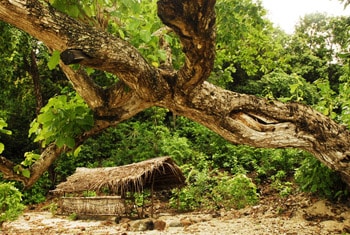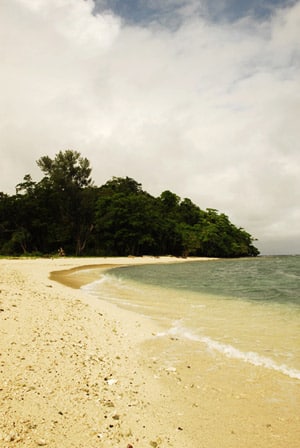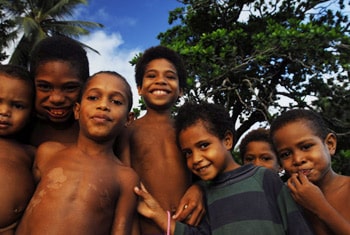Papua New Guinea Up Close
Check out more info about Papau New Guinea and other exciting places...Visit islands.com/planyourtrip
PAPAU NEW GUINEA UP CLOSE
How on earth did these villagers know we were coming? Here we are, my husband, Macduff Everton, and I, in a place in Papua New Guinea where there is no phone, no e-mail, no mail, not even electricity or outside visitors. And yet the 400 people of this village, Watam, have turned out to greet us in full bilas finery as we step off our Zodiac boats near the mouth of the mighty Sepik River. One woman adorned with colorful shells and plants daubs fuchsia goo on my cheek, a paste made from the annatto seed, as a gesture of hospitality. I bow my head to accept a lei of sweet-smelling frangipani blossoms. I soon learn the key to pulling off this remote welcome: drums. Our guide, the aptly named Justin Friend, admits he's only been able to arrange it a few times. "I e-mail a linguist who works with a village at the end of the road — literally, at the road's end," he says. "The message is conveyed from village to village solely by garamut drum, which is basically a hollow log, till it gets all the way up to Watam.
It comes back, received in the same manner — by village drumbeat — and carries on down the road. Everyone in the village has a signature drumming pattern that's too complicated for me. When I use the garamut, I just beat out some nonsense, and they say, 'Oh, that must be Justin trying to reach the chief!'" We've never seen anything like it in our 20 years traveling together. Usually we let serendipity be our guide, but this time we signed up with Justin and, yes, a cruise line. Not an oversized floating resort but an expedition cruise that promised authentic experiences in the hard-to-reach spots of Papua New Guinea in the South Pacific. Tauck World Discovery chartered a small luxury ship, the Orion, to carry 85 guests and 75 crew members on a 12-day trip, using Zodiacs to maneuver to shore. Still, this is a guided, planned itinerary without much room for serendipity. I'm skeptical. It's clear we're part of a cruise when I look at us, so different from the Watam revelers. Outsiders on Papua New Guinea are simply, not maliciously, called dim-dims. Dim as in witted, and we rate a double — our faces all zinced up with sunscreen, large floppy hats, baggy clothing mostly in the khaki shade, dark, googly eyeglasses. I start to feel we have no chance of a genuine welcome beyond this show for the cruise people. But what a show it is. A gigantic, thrumming dragon soon appears, its scarlet-faced head created with a clutch of pandanus branches, feathers, paint and shells. We follow the dragon along an immaculate path into the village proper. Thatch houses for the families of Watam's seven clans flank both sides of a common area, which is more like a grassy thoroughfare. Here the dragon disassembles into a score of men, each embellished with body paint, shells, bones, tusks and feathers, dancing up a storm. They sing. They soar like birds. They rattle like serpents. Their skin carries the scent of sweet red dye and coconut oil. We're experiencing this thanks to Justin, an amiable soul with a Santa Claus frame and a heart to match.

It's not just the drums but Justin's acceptance here that has opened the route for us. Curiosity pulled this Aussie from a good job working on the Great Barrier Reef into the wilds of Papua New Guinea a dozen years ago. He wanted to experience life in the villages, and in the beginning he just showed up with his tireless, trusting grin. The people warmed to him. Justin plied the coastline in a small outboard, journeying up rivers and into the highlands. He learned pidgin, fell in love with a Highland woman and married her, built a home, even became a village chief. The friendships Justin cultivated opened up a centuries-old clan system of relationship and alliance. There is a cycle of reciprocal giving and receiving called the Kula Ring that binds islanders for miles across treacherous seas in a network of trust and alliance. Justin has earned a place in this ring. The Watam dancers regroup for a formal presentation of the school supplies, medicine and clothing that Tauck has brought to the clan chiefs and the schoolmistress. A marketplace is in full swing, as people from Watam and neighboring villages spread their wares. Getting into the groove, we dim-dims begin accumulating shell necklaces, carved walking sticks, masks, bowls, toy birds and boats. We become walking assemblages of both worlds as this buying spree brings glee to shoppers and sellers alike. Justin grins as he watches Macduff select a golden kina-shell necklace for me to try on.
Over the course of the afternoon, the villagers take note of how I call to my husband. When we climb back into the Zodiac, now laden with such a rainbow of handmade objects it looks more like a carnival float than a black rubber boat, they wave, "Goodbye, Miss Mary! Goodbye, Mister Sweetie!" Leaving Watam, the Orion motors to the mouth of the more-than-700-mile-long Sepik River. We use the Zodiacs to watch white-tailed eagles and Brahminy kites soar and hunt along the riverbanks. We cross a distinct divide in the water where freshwater discharge from the thousand-foot-deep river empties into the teal-colored Bismarck Sea. In late afternoon, we head south toward Madang as dolphins dart across our bow. The next morning in Madang's harbor, the smell of toasted coconut seasons the air. Copra is processed here to extract its oil for soaps and food. A group of beautifully ornamented kids and adults welcome the ship with more song and dance. To their feather-and-shell headdresses they've added white doves cut from cardboard boxes, a touch that would make any collage artist proud. We transfer to small buses to check out the bustling Madang market and a nearby village, Bilbil. Afterward we head for the bar at Madang Resort, the main hangout in a town straight out of a Somerset Maugham novel with its desultory, colonial feel. On the way, we walk past a group of ladies seated along a riverbank. Justin chuckles, "This here is called the 'leandown market,' because you have to lean down to buy their smoked fish and produce." Over South Pacific beers, we recap our visit to Bilbil earlier that morning. The villagers' ancestors were great seamen, sailing two-masted canoes for hundreds of miles along the coast, trading wood-fired containers they made from river clay for food and other items they lacked on their little islet just offshore of Madang.

Now their village has relocated to the mainland, and their clay wares are decorative — small enough for a tourist's pack — but still made in the original way, as they demonstrated for us. Eschewing potter's wheel and coil, they press down into a solid chunk of clay, alternately spanking it into shape and hollowing it, as if it were a carving — not unlike gouging out a log in order to make a canoe. As we leave Madang, cruising past green hills tattooed with shadows, we head for Cape Nelson's volcanic fjords and the bay of Tufi. Around midnight, my husband and I go on deck. We watch the gleaming white wake of the ship split the stark, black sea as stars glitter among the clouds. At sunrise I see the long arm of Cape Nelson stretching into the oily, calm Solomon Sea. Created by a massive surge of lava from three volcanoes, fingerlike tropical fjords nearly 300 feet deep rise another 450 feet into the moist, blue sky. The mysterious fjords are protected by a healthy coral-reef system. We ride in outrigger canoes manned by paddlers into a mangrove-thick world of beauty to a garden area below the Kofure village at Tufi. Foliage mirrored in the water fractures into a green mosaic. Mangrove roots and their refl ections create diamond patterns, chevrons and wiggles — the same designs that appear as motifs on the tapa-bark cloth for which this area is famous.
By now I know the drill: singing and dancing, time for photos and a demonstration. It's not that I am becoming blasé; it is because this is becoming less "other." The ubiquitous T-shirt shows up amid Missionary-style floral muumuus and bark cloth. English is now the language we hear most, replacing the tok pidgin that originated in the colonial era when villagers worked the mines, plantations and fields. Today's villagers are sharing with us a smidgen of what it is like to live here, graciously putting up with dim-dim dogged eagerness. Every place entertains us and shows us courtesy. In the town of Tufi, we learn how the pithy center of a sago palm is washed, shredded, baked into a loaf and then wrapped for storage using only leaves. On the island of Panapompom, we meet one extended family — the remains of what was once Australian Dusty Miller's copra plantation workforce — that comprises Panapompom's entire population. On Kitava, one of the Trobriand Islands, we hike to a village above the beach where women are plaiting pandanus leaves into mats as their babies sleep under netting. On an uninhabited islet called Nivani, or as I call it, Nirvana, we snorkel in the heat of day over a submerged Japanese Zero. Every visit ends with the marketplace and with exchanges that become utterly familiar: Kids show us their classrooms, mothers and fathers show us their babies. We show photos and trade addresses, baseball caps and purses. In one village, I ask to remain behind in between two groups' visits from the ship. I mistakenly believe I will be able to wander about looking, making some sketches, perhaps playing with the children. But it soon becomes obvious that after their formal welcome to our initial band of 30 — in which kids belted out the national anthem and dancers performed with full body paint and facial tattoos — they're done. They want a break before the next group of ours comes to this spit of sand below the village proper — but here I am, this dim-dim.
What am I still doing here? What should they do? In this very traditional and scarcely traveled place, the chief, Josiah Suruba, puts me with his wife, Ivy Elsie. So we sit, and — as gals do — we check each other out. She tries on my bracelet. I admire her tapa cloth. She notices my woven bag from the Peruvian Amazon, counts the strands and makes a mental note of the pattern, which is distinct but similar to the New Guinean bilim bags. Then her eye turns to four of her five children, whom she introduces as they gather around her and this stranger on a wood plank between two logs. She nudges me and nudges me again down the plank, I finally realize, to afford me more shade as the sun nibbles away at our bench. She offers me refreshing pineapple. I pull out photos of my mother, Claire, and my granddaughter, Aida Claire. A group of ladies comes closer, jockeying to take a look. A few of them have full-face tattoos, and others sport soccer jerseys. Then, when the boat comes for me, Ivy Elsie stands. Perhaps to be spared another sight of the ungainliness she noticed when I first slung my bag, camera, hat and notebook about like a flailing, hooked fish, she insists on carrying my bags to the boatman. The relieved villagers shout goodbyes, knowing they took good care of this dim-dim as they wave her on her way. On our final day of the cruise, we sail from Cape Nelson to Alotau in Milne Bay, where a shipping agent helps passengers send souvenirs home. Piles of booty fill the lounge. After I list my items, the agent admires a few. She has no idea what we have done. To her, we are clients on a fancy ship.
As I tell her how I acquired a certain inlaid bowl from an ancient man with smiling eyes, I feel a surge of emotion, as my recollection is so vivid. I tell her how we came all the way to Papua New Guinea on this expedition cruise to meet the people and learn something of their islands and culture. I mention that we brought school supplies, medicine and children's clothing for our stops near the Sepik, in Madang Province, in the Trobriand Islands, and even on a one- family islet named Panapompom. She reaches for my hand, saying, "Thank you — thank you so much." "No, thank you and this amazing country," I reply. Again, she returns the thanks, holding my hand. This island cruise, strung together with mesmerizing days at sea, ends in this handclasp. It is our own Kula Ring, and now I know what it feels like to be in it.
